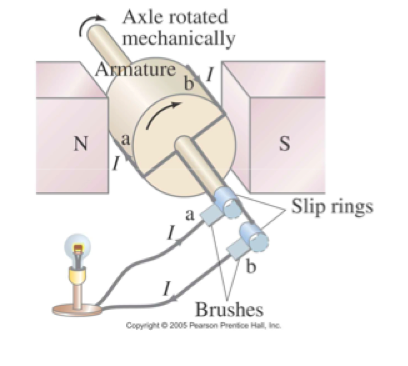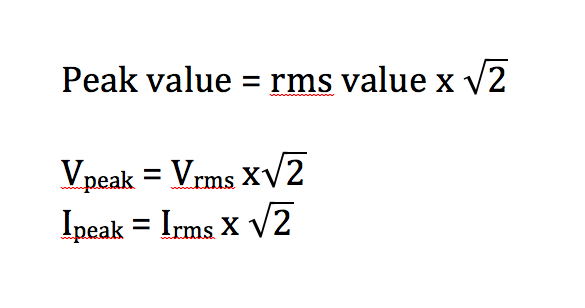Cards In This Set
| Front | Back |
|
12.1.1
Describe the inducing of an emf by relative motion
between a conductor and a magnetic field
|
A changing magnetic field induces an emf — current
within a conductor. Such a current is called an induced current. Motion or
change is required to induce an emf. If does not matter whether the magnet or
the coil moves.
|
|
12.1.2
Derive the formula for the emf induced in a straight
conductor moving in a magnetic field
|
 See image. |
|
12.1.3
Define Magnetic Flux and Magnetic Flux Linkage
|
1.
*Magnetic Flux (Φ) - product
of the magnetic field strength and a cross-sectional area and the cosine of the
angle between the magnetic field and the normal
to the area (Φ = B A cosθ)
2.
*Magnetic Flux Linkage –
product of the magnetic flux through a single coil and the total number of
coils (flux linkage = N Φ)
|
|
12.1.4: Describe the production of an induced emf by a time
changing magnetic flux
|
 See image. A time changing magnetic flux will induce an emf in a circuit or coil (conductor). |
|
12.1.5
State Faraday’s and Lenz’s Law
|
1.
*Faraday’s Law - The
emf induced by a time changing magnetic field is proportional to the rate of
change of the flux linkage. (ε α N
ΔΦ/Δt)
2.
*Lenz’s Law - The
direction of an induced emf is such that it produces a magnetic field whose
direction opposes the change in magnetic field that produced it. (NOTE: This is
the negative sign added to Faraday’s law.
ε= - N ΔΦ/Δt)
|
|
12.2.1
Describe the emf induced in a coil rotating within a
uniform magnetic field.
|
 See image. Students should understand, without any derivation, that the induced emf is sinusoidal if the rotation is at constant speed. |
|
12.2.2
Explain the operation of a basic alternating current
(ac) generator.
|
 A generator consists of many loops of wire wound on an armature that can rotate in a magnetic field. The axle is turned by some mechanical means and an emf is induced in the coil. |
|
12.2.3
Describe the effect on the induced emf of changing the
generator frequency.
|
 Students will be expected to compare the output from generators operating at different frequencies by sketching appropriate graphs. |
|
12.2.4
Discuss what is meant by the root mean squared (rms)
value of an alternating current or voltage.
|
Students should know that the rms value of an
alternating current (or voltage) is that value of the
direct current (or voltage) that dissipates power
in a resistor at the same rate. The rms value is also
known as the rating.
|
|
12.2.5
State the relation between peak and rms values for
sinusoidal voltage and currents
|
 See image. |
|
12.2.8
Describe the operation of an ideal transformer.
|
See image.
|
|
12.3.1
Outline the reasons for power losses in transmission
line and real transformers
|
Power
loss in transmission line:
Heat loss due to current Resistance of the metal used Dielectric losses Self-inductance Power loss in real transformers: Eddy currents Resistance of the wire in the winding Hysteresis Physical Vibration Dielectric losses Electromagnetic radiation Flux leakage |
|
12.3.2
Explain the use of high-voltage step-up and step-down
transformers in the transmission of electrical power.
|
Students should be aware that, for economic
reasons, there is no ideal value of voltage for
electrical transmission.
The voltage is step-up from the power plant to have a higher power output due to power dissipating. The voltage is then step-down when the power has reached its consumer source (where the power is being consumed). There is no ideal valve of step-up voltage due to economic reason. From the power plant, a step-up transformer is used to increase voltage (so that current is decreased) from 11,000 V to 250,000 V. from the transmission line to city storage, a step-down transformer reduces voltage from 250,000 to 4500 V. then in front of a house, a step-down transformer reduces that to 200-240V. |
|
12.3.4
Suggest how extra-low-frequency electromagnetic fields
such as those created by electrical appliances and power lines induce currents
within a body.
|
A human body is a conducting
medium, so when it is moving in an alternating magnetic field at
extra-low-frequency, then electric field is induced, hence inducing current in
human body.
|
|
12.3.5
Discuss some of the possible risks involved in living
and working near high-voltage power lines.
|
Students should be aware that current experimental
evidence suggests that low-frequency fields do not
harm genetic material.
Students should appreciate that the risks attached
to the inducing of current in the body are not fully
understood. These risks are likely to be dependent
on current (density), frequency and length of
exposure.
Current experimental evidence suggests that low-frequency fields don’t harm genetic material. There has been evidence that this may lead to infant cancer and infant leukemia. |



